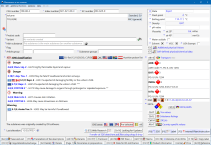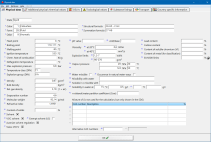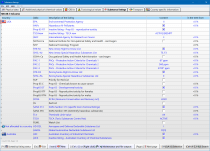Raw Materials Database
- About 25.000 different substances (download)
 GHS classification for all substances (Globally Harmonized System)
GHS classification for all substances (Globally Harmonized System)- taking the various national regulations (for example OSHA HCS, HPR, CLP, UN GHS) into consideration
- National GHS classifications for Australia, China, Japan, Korea, Malaysia, South Africa and Taiwan, as well as self-classifications (can additionally be entered by the user)
- for easier understanding, R and S phrases are still included
- taking the various national regulations (for example OSHA HCS, HPR, CLP, UN GHS) into consideration
 Search possibilities
Search possibilities- CAS number
- Company internal product codes
- Index number
- EC number (former EINECS number)
- UN number
- Text components (including wildcards)
- Registration number (REACH)
- CAS number
- More than 550.000 descriptions for substances in 28 different languages:
Arabic Danish Finnish Hungarian Latvian Polish Slovenian Bulgarian Dutch French Italian Lithuanian Portuguese Spanish Chinese English German Japanese Malay Serbian Swedish Czech Estonian Greek Korean Norwegian Slovakian Turkish
We would like to point out, that some descriptions are not implemented in all above-mentioned languages in the ChemGes database, as the official translations in several languages are (partly) unavailable due to legal circumstances (for example: descriptions of many listed substances in Annex VI were published in English only).
 Chemical and physical data
Chemical and physical dataStructural formula, summation formula Density Molecular weight Content of solids State of aggregation Lead content Color, Form, Odor Content of soluble chromium (VI) pH-value Carbon content Miscibility / Solubility Content of metal (for the classification) Boiling point Explosion limits Flash point Ignition temperature Vapour pressure Deflagration temperature Evaporation number Max. explosion pressure Molecular weight Chemical heat of combustion Refractive index Explosion group (DIN) Viscosity Temperature class (DIN)
- Threshold values for the USA, Canada, all of Europe and other countries
 Country specific characteristics, e.g.:
Country specific characteristics, e.g.:RTECS number VbF-class (Regulation for the storage of inflammable liquids) for Austria Betriebssicherheitsverordnung for Germany Seveso III (Directive 2012/18/EU) Swiss Toxicity Class Swiss VOCV Danish MAL Code German BAT values Water Hazard Classes for Germany (VwVwS) and the Netherlands (ABM) Biocidal Products Regulation UFI code
 Waste catalogues
Waste catalogues- Complete EU waste catalogue in all EU languages, Norwegian, Serbian and Turkish
- Register of the Austrian as well as the Swiss Waste Codes
- Properties of waste which render it hazardous (HP codes) according to the EU Directive on waste
- Korea
- Toxicological values
- LD50 oral
- LD50 dermal
- LC50/4h inhalative
- Transportation classification for most of the substances
 Substance listings
Substance listings- USA
- SARA Section 355
- SARA Section 313
- Toxic Substances Control Act (TSCA)
- Protective Action Criteria for Chemicals (PACs)
- Proposition 65
- New Jersey Right- to- Know List
- New Jersey Special Hazardous Substances List
- Pennsylvania Right-to-Know List
- Pennsylvania Special Hazardous Substances List
- Resource Conservation and Recovery Act (RCRA)
- Hazardous Air Pollutants (HAPs)
- Cancerogenicity categories
- Environmental Protection Agency (EPA)
- International Agency for research on cancer (IARC)
- National Toxicology Program (NTP)
- TLV National Institute for occupational Safety and Health (NIOSH)
- Occupational Safety and Health Administration (OSHA)
- Environmental Protection Agency (EPA)
- SARA Section 355
- Canada
- Canadian substance lists Domestic Substance List (DSL)
- Ingredient Disclosure List (0.1%, as well as 1%)
- Canadian substance lists Domestic Substance List (DSL)
- European Community
- European Inventory of Existing Commercial Chemical Substances (EINECS)
- European List of Notified Chemical Substances (ELINCS)
- Substances of very high concern (SVHC)
- PBT (persistent, bioaccumulative, toxic substances)
- vPvB (very persistent, very bioaccumulative substances)
- REACH Annex XIV
- REACH Annex XVII
- REACH Pre-registered substances
- PIC
- EuPCS
- EU RoHS-List
- European Inventory of Existing Commercial Chemical Substances (EINECS)
- Australia
- Australian Inventory of Chemical Substances (AICS)
- Standard for the Uniform Scheduling of Medicines an Poisons (SUSMP)
- Australian Inventory of Chemical Substances (AICS)
- Japan
- Existing Chemical Substances (ENCS)
- Biodegradation and Bioconcentration of Existing Substances (Bio ECS)
- Chemical Substances Relating to a Public Notice (CSRPN)
- Monitoring Type II/Type III Monitoring Chemical Substances
- Priority Assessment Chemical Substances (PACS)
- Specified Chemical Substances (SCS)
- Toxicity Tests Results (TTR)
- PRTR Designated Substances
- PDSC Deleterious Substances, Poisonous Substances, Specified Poisonous Substances
- ISHA
- Existing Chemical Substances (ENCS)
- The Netherlands
- NIET
- SZW
- Lijst van Potentieel Zeer Zorgwekkende Stoffen
- Lijst Zeer Zorgewekkende Stoffen
- Korea
- Korean Existing Chemical Inventory (KECI)
- CCA
- ISHA
- Korean Dangerous Substance List (KDSL)
- Korean Existing Chemical Inventory (KECI)
- Thailand
- HSL Thailand Hazardous Substance List - Department of Agriculture
- HSL Thailand Hazardous Substance List - Department of Energy Business
- HSL Thailand Hazardous Substance List - Department of Fishery
- HSL Thailand Hazardous Substance List - Department of Food and Drug Administration
- HSL Thailand Hazardous Substance List - Department of Industrial Work
- HSL Thailand Hazardous Substance List - Department of Livestock Development
- Existing Chemicals Inventory, DIW
- Singapore
- Singapore Health Products Act - First Schedule
- Singapore Poisons Act - Schedule 1
- Singapore Poisons Act - Schedule 2, Group II
- China
- Chinese Chemical Inventory of Existing Chemical Substances (IECSC)
- Catalogue of Hazardous Chemicals
- Taiwan
- TCSCA Control concentration standard (w/w%)
- TCSCA Large-scale handling standard (kg)
- TCSCA Regulatory control number
- TCSCA Toxicity classification
- TCSI Taiwan Chemical Substance Inventory
- New Zealand
- New Zealand Inventory of Chemicals (NZIoC)
- HSNO Approval Numbers
- New Zealand Inventory of Chemicals (NZIoC)
- Philippines
- Philippines Inventory of Chemicals and Chemical Substances (PICCS)
- Philippines Inventory of Chemicals and Chemical Substances (PICCS)
- Other substance listings
- Global Automotive Declarable Substance List (GADSL)
- Aerospace and Defense Declarable Substance List (AD-DSL)
- International Nomenclature of Cosmetic Ingredients (INCI)
- Global Automotive Declarable Substance List (GADSL)
- USA
We want to emphasize the following facts:
- The CAS number registry contains more than 130,000,000 substances with CAS numbers.
- The provided raw materials in our database can only be a small subset of the contents of the CAS number registry and contain the most common chemicals. Usually customers have to add their own chemicals. The percentage of chemicals in our database, which a company might use, varies depending on the type of industry. Please view the list of chemicals in our database to check for completeness here.
- As ECHA expressly prohibits the transfer of substance specific data to other software, we can unfortunately not provide this information.
- Ecotoxicological data is hardly available. We do, of course, seek to implement as much data as possible into our databases.
- The substance names cannot be made available in all languages, as the necessary translations (for example Thai and Hindi) are not at our disposal. In this case the English substance names are used, which is usually accepted by the national authorities without objection.
- Our database does not contain any mixtures, also not basic mixtures, which might be sold as raw materials.
- Customers have to add missing raw materials by themselves. DR-Software we do not provide such a service.
- Copyrighted material (e.g. TLVs from ACGIH) has to be purchased separately.
pdf manual: Necessary steps for the creation of a raw material